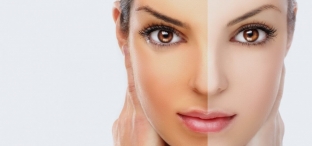The fashion for complexion is extremely changeable – from time to time in society they strive to either flash a bronze tan, or boast of porcelain whiteness skin. And if the swarthy trend is attributed to Mrs. Chanel, then the dream of snow-white skin has haunted women since ancient times, regardless of race and age. The first attempts to whiten the skin are traditionally attributed to the times of Cleopatra, then in the history of world fashion, the names of crowned persons who used skin whitening products periodically flash. Unfortunately, the names of other fans of the whiteness trend have probably been lost due to the unfortunate outcomes of the use of whitening products that are on & nbsp; for a long time included toxic components. How is the situation with such funds now, considered estet-portal.com.
Substances capable of whitening the skin of the face and their dangers
According to the legends from ancient manuscripts, the Egyptian ruler achieved whiteness of the skin with donkey milk baths. Our grandmothers kept lemon juice in their bathrooms to whiten their skin. These substances are considered quite safe for skin lightening purposes, which cannot be said about the products used, say, in England during the reign of Elizabeth the First, and not only in England: the main components in them were mercury, lead, arsenic.
A mixture of white lead and vinegar gave a very pale color of the face, the product made it possible to hide the signs of aging well, but led to a slow poisoning of lovers of snow-white skin. Another popular at that time ingredient in bleaching products – arsenic. It destroyed red blood cells, due to which a noble pallor of the skin appeared, but over time, whitening fans gradually went bald and died from arsenic poisoning. Mercury retained its position as a bleaching ingredient for the longest time – until it has been proven that it can penetrate the skin and cause kidney and liver problems, cause birth defects in children, and eventually also lead to death.
Modern skin whitening cosmetics are certainly monitored by the relevant authorities for consumer safety, but this guarantee can only be expected from products manufactured for the European market.
If a woman goes, let's say, on vacation to India, Southeast Asia or other exotic places, then there she can buy cosmetics with a completely unknown composition. In addition, whitening cosmetics from different countries are very actively sold via the Internet – sales are accompanied by compelling videos that showcase the amazing results of facial whitening.
The use of unknown whitening cosmetics often leads to severe poisoning, and patients do not associate their illness with the use of new face whitening cosmetics. That is why the doctor must, before starting the procedure, ask in detail about all the cosmetic products used by the patient.

Some components of whitening preparations and their action
Let's consider the effect of some other components of facial skin whitening cosmetics, the use of which is prohibited in the EU countries, but is considered quite acceptable in other regions.
Corticosteroids. Steroid creams are very effective in whitening age spots and brightening the skin, but the side effects from their use were so severe that after heated discussions in the medical community, it was decided to ban the inclusion of steroids in cosmetics. So, among the complications that may be due to the use of steroid bleaches, we will name the following:
- atrophy of skin,
- dry skin,
- eczema, purpura,
- appearance of acne,
- development of granulomas.
Immunosuppressive effects of steroids can cause skin infections and allergic reactions up to anaphylactic shock.
Hydroquinone. In medicine, it was long used as a drug with antipyretic and antiseptic properties, but then its high toxicity was discovered, and hydroquinone was quickly removed from medical use. However, in cosmetology, it is still considered one of the most effective bleaches, although numerous studies that have been conducted in different countries define this substance as a carcinogen. Even if it is possible to remove age spots and not get complications from the hydroquinone remedy, the pigmentation often returns after a few weeks.
The problems of combating skin pigmentation are really relevant, and treatment is a long and complicated process, but no matter how much patients would like to speed it up, the doctor should be guided, first of all, by the principle of "do no harm", warn about the seriousness of the consequences and apply only safe drugs.







Add a comment